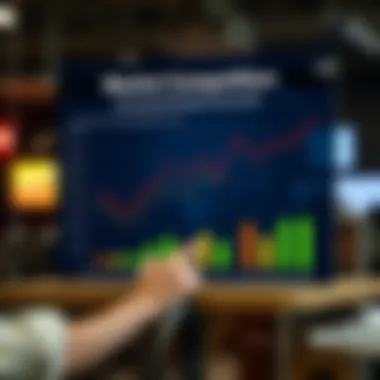The Future of High Yield Savings Accounts: An Analysis


Intro
In our fast-paced financial world, high yield savings accounts have become a beacon for individuals looking to make the most of their money. As the economic landscape changes, so do the factors driving interest rates for these accounts. With inflation concerns, monetary policy adjustments, and increasing competition among banks, understanding where high yield savings accounts are headed is essential for savvy savers.
Navigating the complexities of interest rates requires an informed approach. This article aims to dissect the current trends impacting high yield savings accounts and their future trajectory, ensuring readers are well-equipped to optimize their savings strategies. We will delve into practical advice and insights, shining a light on what consumers should consider when selecting the right account for their financial needs.
Let’s unpack the factors influencing these accounts, from market economics to user-friendly strategies that can enhance your savings game.
Understanding High Yield Savings Accounts
High yield savings accounts have emerged as a critical component of personal finance in recent years. The appeal of these accounts lies in their capacity to offer significantly better interest rates compared to standard savings accounts. This hike in rates is particularly appealing to savers looking to grow their money without taking on the risks associated with investments in stocks or bonds. In this era of low-interest-rate environments, understanding the nuances of these accounts can empower individuals to make informed choices about their savings strategies.
Definition and Purpose
A high yield savings account is a type of savings account designed to pay a higher interest rate than a traditional savings account. Often offered by online banks or credit unions, these accounts leverage technology to reduce operational costs, which allows them to pass on the savings to customers as favorable rates. But why should consumers care?
Firstly, the primary purpose of these accounts is to provide a secure way to save money while earning interest. Individuals typically opt for high yield savings accounts to reach specific savings goals such as building an emergency fund, saving for a holiday, or planning for a major purchase. The higher interest rates mean that your money can grow faster, enhancing your overall financial health. Moreover, since these accounts are typically insured by the FDIC up to a certain limit, consumers can enjoy peace of mind knowing their savings are protected.
Comparison with Traditional Savings Accounts
When analyzing high yield savings accounts against traditional savings accounts, the differences become apparent quickly. Traditional savings accounts usually offer paltry interest rates that barely keep up with inflation, let alone allow for significant growth. In contrast, high yield savings accounts can offer rates that are several times that of their traditional counterparts.
Here are some comparisons to consider:
- Interest Rates: Typical rates for traditional accounts might hover around 0.01% to 0.05% APY, while high yield accounts can range from 0.5% to 2% APY or even higher, depending on the banking institution and market conditions.
- Fees and Charges: Traditional banks may impose monthly maintenance fees, which can erode the benefits of any interest earned. High yield accounts often come with minimal fees or none at all, allowing savers to maximize their returns.
- Accessibility: High street banks might have fewer options for online banking or funds transfer, while many high yield accounts offered by online banks allow for seamless access and transactions through user-friendly apps.
"Choosing the right type of savings account can greatly impact your financial future. Don't underestimate the power of compound interest!"
Current Landscape of High Yield Savings Accounts
The realm of high yield savings accounts has gained significant traction in recent years. Understanding the current landscape is crucial as it informs investors and savers alike about potential shifts in savings strategies. These accounts serve as viable options for individuals seeking better returns for their funds, especially in an environment with growing economic uncertainties.
Recent Interest Rate Trends
Recent shifts in interest rates have made waves in the financial market. As inflation continues to exert pressure on the economy, financial institutions are adjusting their offerings to remain competitive. This has resulted in a mixed bag where some high yield savings accounts now boast rates that were once unimaginable, while others struggle to keep pace.
For instance, as of the last quarter, some banks have begun to offer rates nearing 4%, tempting consumers who previously viewed traditional savings options as inadequate. Even though these rates are appealing, it's essential for consumers to scrutinize the fine print, as fees and conditions can sometimes negate the perceived benefits.
Factors Impacting Current Rates
Multiple elements contribute to the fluctuating interest rates on high yield savings accounts. Understanding these factors can help consumers make informed choices.
Inflationary Pressures
Inflation significantly affects high yield savings accounts. When prices rise, the purchasing power of money diminishes. Interest rates tend to increase in response to inflation as institutions try to offer returns that help consumers keep up with the costs of living. An important characteristic of inflationary pressures is their ability to prompt both consumers and institutions to reassess their saving and investment strategies. For this reason, it's beneficial for savers to keep an eye on inflation trends. However, inflation can lead to higher rates, but it also can create a less favorable savings environment if costs rise faster than interest returns.
Central Bank Policies
The role of central banks in influencing interest rates cannot be overstated. Decisions made by entities such as the Federal Reserve affect money supply and, subsequently, savings rates. A key aspect here is the setting of benchmark rates, which dictate how financial institutions price their products. When central banks adopt accommodative measures, like lowering interest rates, it typically results in lower returns for savers. Conversely, tightening monetary policies often signal higher savings rates. While these policies can support economic stability, they can also leave consumers feeling squeezed, especially when their savings yield little growth.
Consumer Demand for Savings
Current consumer interest in high yield savings accounts reflects a growing tendency towards prudent financial management. The demand for better savings options stems from a desire for security in fluctuating economic conditions. This characteristic of consumer demand highlights a shift where individuals prioritize financial health over spending. However, high demand for better savings might result in intense competition among banks, potentially leading to better rates. Yet, sometimes, institutions might exploit this demand by layering on fees, which can counteract the benefits of any higher rates offered.
In closing this section, the landscape of high yield savings accounts is not merely about the numbers. It's about understanding the broader economic forces at play and how they interact with consumer choices. In turn, this understanding shapes the decisions individuals make about where and how to save their money.
Key Economic Indicators to Watch
Understanding key economic indicators is essential in navigating the landscape of high yield savings accounts. These indicators offer insights into what might happen with interest rates and savings products in the future. By keeping an eye on inflation, Federal Reserve actions, and unemployment rates, consumers can better strategize their savings and investment approaches.
Inflation Rates


Inflation rates serve as a crucial barometer for the economy's health and directly affect the purchasing power of money. When inflation rises, it diminishes the value of savings over time, making it imperative for consumers to seek out accounts that can offer competitive returns. In a world where the prices of everyday goods and services creep upward, a high yield savings account may provide a buffer, especially in turbulent economic times.
Currently, inflation is like a rollercoaster ride—it's unpredictable, which can lead consumers into a state of anxiety regarding their financial planning. A sudden spike in inflation often prompts central banks to raise interest rates to stabilize the economy.
- Consumer Inflation Index (CPI) is the most widely referenced measure.
- Higher inflation can drive banks to adjust the rates they offer on savings accounts, impacting consumer savings.
For example, consider a situation where inflation is at 5%. If your high yield savings account offers 2% return, your savings are effectively shrinking, as the cost of living increases faster than the growth of your funds.
Federal Reserve Actions
The Federal Reserve, colloquially known as the Fed, plays a significant role in shaping the interest rate environment. Its decisions have a ripple effect across the financial system. When the Fed raises or lowers the federal funds rate, it influences how much banks can charge for loans and pay on deposits.
An active Fed means consumers must stay informed about upcoming meetings and announcements which can signal interest rate changes. A decrease in the federal funds rate typically suggests lower returns on savings, while an increase could enhance the appeal of high yield savings accounts.
Consider these actions:
- The FOMC (Federal Open Market Committee) meets regularly to assess economic conditions.
- Policy statements and projections often hint at potential rate changes.
If the Fed indicates it plans to keep rates steady or increase them, it may be a wise time to lock in a high yield savings account, rather than waiting until rates climb higher and your savings can earn more interest.
Unemployment Rates
The unemployment rate is another vital indicator of economic well-being. A high unemployment rate usually means less disposable income among the populace, which can lead to reduced consumer spending. Conversely, low unemployment often correlates with rising wages and increased spending capacity, potentially pushing inflation higher.
It's important to keep in mind the relationship between unemployment, consumer confidence, and savings behavior. When more people have jobs, they’re more likely to save and invest, driving competition among financial institutions for higher yielding products.
- Current trends can be found through reports on government websites such as bls.gov.
- Regular monitoring of unemployment trends allows consumers to gauge broader economic shifts.
In essence, as unemployment falls and job opportunities grow, consumers feel increased confidence, possibly leading to a higher demand for high yield savings options as people seek to secure their savings effectively.
Staying informed about these key economic indicators can give consumers a leg up when choosing the best high yield savings accounts and planning their financial futures.
Predictions for High Yield Savings Rates
Predicting high yield savings rates is akin to navigating a labyrinth; one needs to be observant and methodical. The significance of this topic in our exploration of high yield savings accounts cannot be overstated. It offers insights into potential shifts in interest rates, which greatly influence consumer decisions and bank strategies. As market dynamics fluctuate and economic conditions change, understanding these forecasts becomes vital for anyone whose financial well-being hinges on optimal savings strategies.
Economic Growth Projections
Economic growth has a direct bearing on the interest rates offered on high yield savings accounts. When the economy is on the upswing, consumer confidence typically rises along with spending, businesses grow, and investments increase. In such an atmosphere, banks may start to offer hotter rates to attract deposits, banking on the expected increase of consumer funds.
Considering the GDP growth rate can provide critical insight. If projections indicate sustained growth, individuals might see higher interest offerings on their savings. Take the current clime:
- If the GDP is expected to grow by 3% in the coming year, banks might react by raising savings rates to capitalize on the influx of deposits.
- Conversely, in periods of economic stagnation, banks may tighten their belts and lower rates, reflecting a more cautious market.
The relationship can be complex, as banks must balance enticing consumers with the realities of their operational costs. Thus, keeping a close watch on economic forecasts gives savers a tool to predict how their savings might fare.
Impact of Monetary Policy Shifts
Central banks serve as the compass guiding the economy through monetary policy. Their decisions on interest rates echo through the financial landscape, significantly affecting high yield savings rates. When the Federal Reserve or corresponding entities alter rates, they set off a chain reaction.
For example, if the Federal Reserve opts to raise interest rates to curtail inflation, financial institutions will likely follow suit. This increase can lead to higher yield savings account rates as banks vie for consumer funds.
However, the reverse is also true:
- Lowering rates to stimulate borrowing during a downturn may lower savings rates, as banks have less incentive to reward savers.
Additionally, changes in policy do not happen in a vacuum. The timing of these shifts, along with public sentiment and global economic conditions, creates a complex backdrop. Savers must remain alert to announcements from the Federal Reserve, as these can provide crucial hints about future savings rates. Paying attention to meetings and reports can help one stay ahead of the curve.
"Understanding the broader economic indicators is not just an exercise in academic curiosity, it is essential for anyone serious about optimizing savings in today's financial landscape."


For deeper insights into economic policies, check out resources like Investopedia or the Federal Reserve.
Market Competitiveness and Its Role
Market competitiveness plays a crucial role in the realm of high yield savings accounts. As interest rates fluctuate due to various factors, the competitive landscape among financial institutions can significantly influence the rates offered to consumers. In essence, the more institutions vying for a share of the savings market, the better it is for consumers seeking to maximize their returns.
Comparison of Leading Financial Institutions
When looking for high yield savings accounts, it is vital to assess the offerings of various financial institutions, especially traditional banks versus online banks. Leading financial institutions like Goldman Sachs, American Express, and Marcus are known for their attractive rates. Each of these offers different interest rates, account fees, and associated terms.
- Interest Rates: Traditional banks have been slow to adapt to the changing rates. They often provide more conservative interest rates compared to their online counterparts. In contrast, online banks such as Ally or Discover tend to offer more competitive rates due to lower overhead costs, which they can pass on to customers.
- Account Fees: It's wise to scrutinize the fine print. While some banks tout high rates, they may also impose hefty monthly fees. Others might offer fee-free accounts with the same interest rates. This difference can affect overall savings potential, making it essential to compare these elements.
- Customer Service: While online banks can often match or exceed interest rates, customer service experience can differ. Traditional banks provide face-to-face interactions, which some consumers prefer, while online institutions may excel in offer prompt support via chat or phone.
"The competition among banks is fierce. It’s not just about rates, but what’s on the table overall in terms of service and fees."
Emergence of Online Banks
The rise of online banks has reshaped the high yield savings landscape entirely. With minimal physical presence, these institutions have streamlined their operations, offering more appealing interest rates than traditional banks. Here are some aspects to consider about online banks:
- Higher Returns: On average, online banks tend to provide higher returns because they save on physical branch costs and can reinvest those savings into higher yields for customers.
- User Experience: Most online banks utilize cutting-edge technology, presenting an intuitive user interface, and mobile app support. Many younger consumers gravitate towards these platforms, valuing ease of access from their smart devices.
- Flexibility and Terms: Online banks often feature favorable terms, such as no minimum balance requirements or limited fees, unlike traditional institutions. This flexibility allows savers to manage their finances without worry.
Online banks have certainly stirred the pot in the world of high yield savings accounts, pushing traditional banks to rethink their strategies to remain competitive in a rapidly evolving market, which brings advantages to consumers that were not previously available.
Consumer Considerations in Choosing Accounts
When navigating the maze of financial options, choosing a high yield savings account entails several key factors. It goes beyond the lure of a sweet interest rate to encompass a broader range of considerations that can affect both the growth of your savings and your overall financial health. For anyone keen on optimizing their savings, understanding these elements is of utmost importance.
Evaluating Interest Rates vs. Fees
A frequent trap many fall into is focusing solely on interest rates when comparing accounts. While a high yield on your savings can be very tempting, it's crucial to consider any associated fees.
- Fees can erode your earnings significantly. Even a seemingly minor maintenance fee can chip away at your overall savings growth, particularly if the interest rate is not considerably higher than that of a traditional account.
To make a well-informed choice, look for accounts that offer high yields with minimal fees. Remember, a good strategy may involve:
- Comparing fees across multiple institutions.
- Finding accounts with the lowest fees relative to interest rates.
- Paying attention to potential hidden costs that may not be immediately clear.
Accessibility and Withdrawal Options
Accessibility is a critical component of your savings strategy. Some high yield savings accounts instill a sense of restriction, with limited access to funds. This can be frustrating when you find yourself in need of cash.
Here’s what to keep in mind:
- Withdrawal Limitations: Some banks enforce monthly withdrawal limits. Frequent access might lead to fees or penalties, making it harder to manage your finances efficiently.
- Transfer Options: How easy is it to move your money in and out? Look for banks that provide an intuitive online banking interface. Make sure electronic transfers and ATM access are both straightforward and free of charge.
- Emergency Funds: If you're maintaining an emergency fund, consider an account that provides both decent returns and easy access during crises.
Financial Institution Reputation
A bank's reputation can influence your experience as a customer. It’s not just about the numbers; trust is vital when it comes to managing your hard-earned money. Before signing, keep an eye on:
- Online Reviews: Platforms like Reddit can offer real user experiences. Search for feedback regarding ease of access, customer service responsiveness, and overall satisfaction with the institution.
- Financial Stability: Research the institution’s financial health through resources like the FDIC. A bank's stability can safeguard your assets, especially in volatile economic times.
- Customer Service: A responsive and helpful customer service team can make a world of difference when you need assistance. Choose a bank known for strong support systems.
In today’s competitive financial landscape, making the right choice can significantly influence your savings journey.
By keeping these factors in mind, you not only increase your chances of maximizing your savings but also create a more secure financial future. As you move forward, weigh the benefits of each account with conscious thought, and prioritize what matters most to your financial well-being.
Strategies for Maximizing Savings
In today's financial landscape, where interest rates can feel akin to a roller coaster ride, it becomes ever more critical to adopt effective strategies for maximizing savings. High yield savings accounts are prominent, but merely having one is not the end of the story. The strategies involved must revolve around assessing personal circumstances, market conditions, and being proactive in managing funds. The right strategies can mean the difference between sitting on a modest pile of cash or actually watching it grow at a rate that keeps up with inflation.


Leveraging Multiple Accounts
One major aspect often skipped over is the idea of utilizing multiple high yield savings accounts. When it comes to saving, don't put all your eggs in one basket. By spreading your money across several accounts, you can tap into a variety of benefits:
- Higher Overall Yield: Different banks offer varying interest rates. When one account goes on to offer a better rate, it may pay off in spades to have your money allocated across multiple spots to cash in on that.
- Access to Different Features: Some banks may offer features tailored for short-term savings versus long-term goals—or vice versa. This allows for flexibility based on needs.
- Enhanced FDIC Protection: If your savings exceed the $250,000 mark, consider maintaining accounts at different institutions. Each account insured by the FDIC provides protection up to that amount.
"Put your money to work in various fields. You never know where the best growth will sprout."
Using this strategy, you can also create a goal-oriented approach, allocating funds in each account for specific purposes such as emergency expenses, vacations, or big ticket purchases. This flexibility adds to the psychological edge of saving, as seeing separate accounts with designated purposes may encourage one to contribute more consistently.
Automating Saving Processes
Another robust strategy is automation. Automating your savings process leverages technology to ensure that you don't inadvertently skip saving. Here are a few key benefits tied to this:
- Consistent Contributions: When funds are automatically transferred from your checking to savings account, you can cultivate a habit without laboring over decisions each month. It’s comparable to paying yourself first, making saving a priority rather than an afterthought.
- Reduced Temptation: Out of sight often translates to out of mind. When savings are diverted before they even hit your main account, the likelihood of spending that amount diminishes greatly.
- Accommodating Financial Goals: You can set up different automated transfers for varying financial goals. Whether that's saving for a new car, a rainy day, or even a dream vacation, automation makes it simpler to ensure that these goals are reached steadily over time.
In fine-tuning your savings strategy, consider tackling the small habits—such as automating your contributions—to capture big time results in wealth accumulation.
In the world of high yield savings accounts, there lies a treasure trove of possibilities. Understanding the lay of the land and employing solid strategies can transform passive saving into a dynamic, engaging process.
The Future of High Yield Savings Accounts
The landscape of high yield savings accounts is evolving in response to a variety of economic trends and consumer behaviors. Understanding this future is crucial not only for investors but for anyone interested in effective financial management. High yield savings accounts offer an attractive option for growing savings, often providing better returns than traditional savings accounts. However, the specific features, rates, and potential moving parts in this realm can significantly impact their effectiveness. Thus, it's essential to grasp the future of these accounts, looking beyond mere numbers to analyze potential innovations and shifts that could redefine the savings experience.
Long-Term Interest Rate Trends
Long-term interest rates for high yield savings accounts will likely mirror broader economic indicators, though they will also be shaped by consumer behavior and bank competition. Over the past few years, fluctuations in interest rates have been driven largely by central bank policies and broader financial markets. As inflation seesaws, so do the rates that banks offer.
One of the crucial concepts to understand is the correlation between the Federal Reserve's actions and interest rates. When the Fed lowers rates to stimulate the economy, high yield accounts often see a corresponding drop. Conversely, if inflation pressures persist and the Fed adjusts rates upward, consumers can expect higher returns.
- Historically, when inflation rates remain elevated, banks might increase their high yield savings account rates to attract depositors. This may also be a strategic move to counterbalance the dwindling purchasing power of savings due to rising prices.
- It's vital for consumers to keep an eye on these trends; the ability to pivot accounts as rates fluctuate can be the difference between stagnant savings and flourishing ones.
With tech advancements and a push towards digital banking, banks are also feeling the heat from other financial institutions. This market competitiveness can lead to favorable interest rates for consumers, as institutions often jockey for customer deposits to maintain liquidity.
“Nonetheless, while the basics remain the same, the way banks present their products is changing; consumers should be ready to adapt.”
Potential Innovations in Banking Products
As the banking industry develops, so do the products tied to high yield savings accounts. Innovations may range from enhanced digital user experiences to more personalized financial products. Online banks have already paved the way, challenging traditional banking with lower fees and higher yields. As customer expectations evolve, banking institutions are pushed not just to keep pace, but to leap ahead in offering value.
Some trends to watch for include:
- Integrated Financial Health Tools: Future high yield savings accounts could integrate tools helping users to manage budgets directly within their banking app. This can empower customers to see how their savings goals align with their spending habits.
- Tiered Interest Rates: Some institutions are exploring tiered interest rates for savings accounts, where different account balances accrue different rates of interest. This can encourage users to save more by incentivizing larger balances.
- Sustainable Banking Products: As ethical investment becomes more prominent, consumers might see savings accounts linked directly to sustainable practices, echoing their values while helping their money grow.
For further reading, seek out investopedia.com for in-depth financial analyses, or check out nerdwallet.com for personal finance tips tailored to your needs.
Epilogue
Concluding this exploration of high yield savings accounts, it’s essential to emphasize how the topic resonates with today’s financial landscape. Understanding the trends surrounding high yield savings accounts is not just a matter of tracking numbers; it’s about equipping yourself with the knowledge and tools to navigate a complex economic environment. This article outlined the nuances of interest rates, shaped by economic indicators and market dynamics. Having insights into these factors fosters better decision-making, allowing readers to identify opportunities that can maximize their savings in an uncertain future.
Summary of Key Insights
As seen throughout this article, several key points stand out:
- Interest Rates Trends: With interest rates fluctuating, there is a possibility that they will either rise or fall, depending on inflationary pressures and central bank policies. It is vital to remain updated on these shifts.
- Market Competitiveness: The increasing presence of online banks has changed the traditional banking landscape, often leading to better rates for consumers. This competition benefits those looking to open or switch accounts.
- Consumer Awareness: Knowing what to watch for—like fees, withdrawal options, and bank reputation—empowers consumers to make informed choices that align with their financial goals.
"Knowledge is power in financial maneuvers; understanding your options effectively translates to sound choices for financial growth."
Final Thoughts on Saving Strategies
In closing, strategizing savings goes beyond simply finding a high yield savings account. Consider these specific strategies:
- Evaluate Multiple Accounts: Leverage different accounts to optimize the interest earned while ensuring you have access to funds when needed.
- Automate Your Savings: Setting up automated transfers can simplify your savings journey, making it easier to save consistently rather than sporadically.
- Stay Informed: Keep abreast of economic developments and banking innovations. It’s the little things that can make a big difference in where your money ends up being invested.
With all these elements in mind, readers can approach high yield savings accounts not just as a source of interest but as a pivotal part of a broader approach to financial health.







